by Yu-Chung John Ku, conductor and teacher
Taiwan, with a population of 23 million and a total land area of only 36,000 square kilometres, is a small island that is narrow at both ends. It lies off the south-eastern coast of mainland Asia, across the Taiwan Straits from mainland China – a solitary isle on the western edge of the Pacific Ocean. To the north are Japan and Okinawa, to the south are the Philippines. Taiwan is located on the western edge of the Pacific ‘rim of fire’. Therefore, the continuous tectonic movements have created majestic peaks, rolling hills and plains, basins, coastlines, and other wonders. The cultural aspects are also not to be missed. The blending of Min-Nan, mainland Chinese, Hakka, aboriginal, Japanese, and even western cultures has produced a rich plethora of cultural and social color.
With the blend of several different cultural origins, Taiwanese culture is literally one big melting pot. There are many unique types of traditional Taiwanese performing arts; however, choral singing is not one of them. Even though there is some sort of harmonized singing in Taiwanese aboriginal music, such as the wedding songs of the Atayal tribe and the pasibutbut (the eight-part harmony song) of the Bunun tribe, choral music was never a major part of traditional Taiwanese culture. Taiwanese traditional music, especially vocal music, emphasized mostly the solo voice. The idea of the chorus – multipart-singing ensembles – was first introduced to Taiwan during the 17th century, when the Dutch made Taiwan a colony. Western music, however, was not widely introduced to the Taiwanese citizens until late 19th century, and predominantly by Christian missionaries.
In the 17th century, when the Dutch made Taiwan a colony, a number of Christian missionaries came from Europe. One of their major activities was to teach Christian hymns to Taiwanese people, especially to the aboriginals. In order for the Taiwanese to understand, and maybe accept the religion, they put in translations of the biblical text in local Taiwanese Languages, thus marking the beginning of choral singing in Taiwan (musical example 1).
(Click on the image to download the full score)
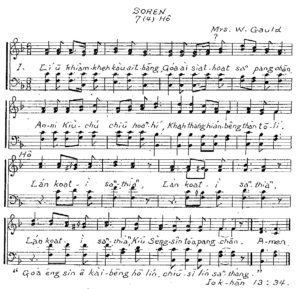
After the Dutch were defeated and expelled from Taiwan in 1662, the Christian religion was prohibited. It was not until the late 19th century, when Taiwan became a colony of Japan, that western missionaries came back to Taiwan again. This time around, in addition to the western hymns with Taiwanese text, some missionaries adapted existing Taiwanese songs and created new Taiwanese hymns – harmonized Taiwanese/aboriginal melodies with biblical text in a local Taiwanese language (musical example 2).
(Click on the image to download the full score)
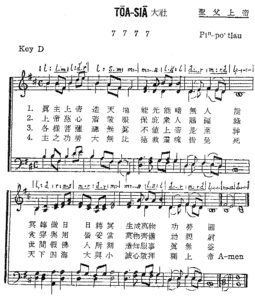
Dr. George Leslie Mackay, a Canadian Presbyterian missionary, established churches, schools, and hospitals in northern Taiwan. In 1907, the Oxford College, one of the schools founded by him, started to offer western music courses, the first school programs for western music taught in Taiwan.
In addition to the western missionaries, the Japanese colonial government also helped to lay the foundation for Taiwanese choral music. During the Japanese colonial period (1895-1945), the Colonial Government established a formal education system based on western models then in Taiwan. Music was an integral part of this system, especially in teacher training schools. And throughout primary school and secondary school, singing was a required course that all students must take. Western music and westernized Japanese songs were the core of these courses – mostly harmonized folk melodies, children’s songs, Japanese art songs sung in Japanese, and some Japanese melodies with Taiwanese text. (Note that Taiwanese folk songs were not allowed.) This requirement allowed people to further explore the art of choral singing and set the basic fabric for the Taiwanese education system until recently.
As mentioned previously, setting Taiwanese or Chinese text to foreign melodies was very common at that time because people sought to harness the power of choral singing by composing new text in the local language to fit foreign choral music. Consequently, primary importance was given to the meaning of the new text, whereas the melodies were used regardless of the original context and mood. For example, in 1926, a song entitled The Citizen’s Revolution was appointed by the Chinese government as a temporary national anthem. With its patriotic text – fight the outside conquerors, fight the corrupt generals, we must work hard for the revolution, we must work and fight together – this decision was appropriate. However, this patriotic song was based on a famous French tune – the children’s song Frère Jacob. The end result was somewhat comical to those familiar with the original (musical example 3).
(Click on the image to download the full score)

Of course, musicians would not be satisfied with just this kind of ‘copied’ music. During Japanese colonial times, the best students were encouraged to study music formally in Japan, even being offered scholarships. Students from Christian schools also went to Japan to further their studies of music. It was at this time that the first group of native Taiwanese art musicians, such as Jiang Wen-Ye (1910-1983), Chen Su-Ti (1911-1992), Lu Chuan-Sheng (1916-2008), Guo Zhi-Yuan (*1921), became known. Even though all their music was composed in the manner of western tonal harmonic procedures, many of the composers were trying to combine Eastern / Chinese / Taiwanese cultural flavor with Western elements. Among these composers, Lu Chuan-Sheng was the one most active in the choral field. He composed more than 200 choral pieces, and founded the first children’s choir in Taiwan – the Rong-Shing Children’s Choir – in 1957. In addition, he organized choral competitions, gave lectures, and hosted choral festivals all over Taiwan. Nowadays, professor Lu is praised as ‘the father of Taiwanese choral music’.
After World War II, Japan returned Taiwan to China in 1945, but in 1949, after the Chinese Civil War, China was separated into two parts: the People’s Republic of China and Taiwan. Hundreds of thousands of people, including a group of composers, retreated to Taiwan. These composers, such as Li Bao-Chen (1907-1979), Huang You-Di (1912-2010), and Lin Sheng-Shih (1915-1991), composed in the style of 19th-century Romanticism with Eastern and Chinese melodies – in other words, pentatonic Romanticism. They worked largely with ancient Chinese poems and contemporary Chinese and Taiwanese lyrics, as well as with folk songs from different corners of China and Taiwan. Huang You-Di, with his numerous artistic awards and over 2000 compositions, was the most influential choral and vocal music composer in Taiwan, Hong Kong, and all of the Chinese-speaking communities in democratic countries across the globe. He passed away in 2010, and in his will he donated his music to the public domain for anyone to use freely.
Being in a democratic country, musicians in Taiwan were fortunate to be exposed to all kinds of new music from Europe and America. Debussy, Stravinsky, and Messiaen were some of the most influential composers, among others. The first generation of composers, after the wars, started out with the traditional pentatonic Romanticism style but began to experiment with the avant-garde technique in the middle of the century. Shi Wei-Liang (1925-1977), Liu De-Yi (1929-1991), and Hsu Tsang-Houei (1929-2001) were those who actively introduced new techniques into Taiwanese music, and mentored generations of Taiwanese composers for the latter half of the 20th century. Hsu Tsang-Houei’s choral piece Song of Flower Burial (premiered in 1962) combines Western compositional techniques, Buddhist pathake singing, Taiwanese theatre singing, a pentatonic scale using the Yu mode (one of the Chinese traditional music modes), and traditional Chinese percussion instruments in this 4-part, a cappella female chorus piece. It marked the beginning of contemporary Taiwanese choral music (musical example 6).
(Click on the image to download the full score)
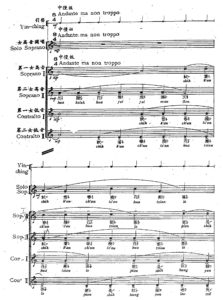
The early 1970s witnessed the awakening of an interest in native culture. The Taiwanese folk song collection projects and the Native Literature movement inspired not only composers but also all performing artists, as well as other social activists. And with the growth of economic power and a rising middle class, Taiwan experienced its most dramatic political and social changes. The liberalized and localized Nationalist government shifted its cultural policy and paid more attention to native subjects and local benefits. So, by the 1980s and 1990s, thousands of concerts and several large or small international music festivals were held in Taiwan by public and private agents every year. New compositions, often specially commissioned, were performed in Taiwan and overseas.
A large group of composers who studied abroad returned to Taiwan and worked closely with conductors who also returned to Taiwan after studying abroad. They made use of contemporary practices, experimented with Chinese and other instruments or unconventional media, emphasized the inflection of pitch and timbre from different Taiwanese languages, and above all, they concentrated on finding a new voice for Taiwan in all their philosophical and aesthetic concepts. Luo Wei-Dao (*1936), Hsaio Tyzen (*1938), Ma Shui-Long (*1939), Yu Chang-Fa (*1942), Chien Nan-Chang (*1948), and Gordon Shi-Wen Chin (*1957) all have large choral outputs. Their works are popular among Taiwanese choruses and are well received by Taiwanese audiences.
Chien Nan-Chang is one of the composers equally active in both symphonic and choral compositions. His choral works have been performed by most Taiwanese choirs and by internationally renowned ensembles outside Taiwan, such as the World Youth Choir, Gustaf Sjökvist chamber choir, and others. His innovative musical concepts, simple but effective compositional language, and humorous word play in the lyrics has won him five Golden Melody Awards, the most prestigious annual musical award in Taiwan. In 2005, he was honoured with the Annual National Culture and Arts Award of Taiwan. Some of his well-received works include The Buddhist Requiem, the choral symphonic works Symphonic Poem on Taiwanese Folk Tunes and The Maiden of Malan, and the a cappella choral suite I Am Flying (musical example 7).
(Click on the image to download the full score)
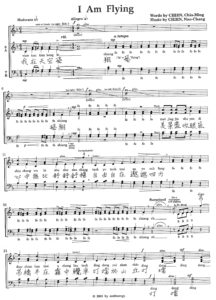
Hsaio Tyzen is often categorized as a Neo-Romantic school composer because of his rich, romantic harmony and sentimental melodic lines. His choral output includes large-scale choral symphonic works and newly composed Christian hymns, as well as Taiwanese art songs. These pieces, all sung in the Taiwanese (Min-Nan) language, are often considered works of Taiwanese Nationalism.
Now, in the early 21st century, a new group of composers has joined the market bringing a new vision to choral compositions from Taiwan. Hsu Ya-Ming’s Zero-Sing for Environmental Protection, with its emphasis on acoustic effects, uses human voices along with a Pipa (a Chinese instrument) and a pre-recorded tape. Wan Yi-Chia (Edgar Macapili) brings in overtone singing and the ocarina to further enhance the presence of Taiwanese aboriginal scenery in his aboriginal choral work Praise the Mountains. On the other hand, Jenny H. Chou and Shi Ching-Ju both have several works based on contemporary Taiwanese and Chinese poems. Their simple, pastoral-style compositions are popular with college and high school choirs, as well as with many community choirs.
Among these composers, Tsai Yu-Shan and Jan Tian-Hao are probably those whose works are most often sung. Jan is most known in Taiwan as a music theater composer (14 full-length music theater works). However, he also works closely with the Taipei Philharmonic Chamber Choir and Taipei Chamber Singers on choral compositions and on arrangements. Tsai has worked with the Formosa Singers for more than a decade. Together with the ensemble, she has published more than 50 choral arrangements of songs in Taiwanese, Hakka, Mandarin, and aboriginal languages. Both Jan and Tsai’s works are performed widely by Chinese-speaking communities all around the world.
When we talk about Taiwanese choral music, there is one key person we should not forget – Professor Dirk DuHei (*1944). As the first formally trained choral conductor in Taiwan, for decades he was the sole power propelling the Taiwanese choral scene to move forward. Since the early 1980s, he has contributed greatly to the Taiwanese music scene in many different ways, such as developing new choirs and helping existing choirs to reach higher levels all over Taiwan, premiering hundreds of new choral compositions and pieces from classic western and Chinese choral repertoire in Taiwan, constantly commissioning new choral works from Taiwanese and Chinese composers, starting competitions, workshops, and festivals of choral music in Taiwan, introducing internationally renowned choirs and conductors to Taiwan, and most importantly, mentoring generations of conductors and composers, and thousands of singers in Taiwan, and also in China. With his enormous efforts, Taiwanese choral music has reached a high standard, becoming one of the leading forces in the Asia-Pacific region.
Today, after many years of development, there are dozens of professional conductors, and a large number of well-trained choirs in Taiwan. Among these ensembles, several choirs devote a lot of time to promoting new Taiwanese choral works. These semi-professional choirs operate actually at a high professional level and are active internationally. Among these choirs, the Taipei Philharmonic Chorus and Chamber Choir (Dirk DuHei, artistic director; Yu-Chung John Ku and ShangLun Wu, music director) was the first choir in Taiwan devoted to promoting quality choral music – including contemporary and classical, from Taiwan and elsewhere. Constantly featured in high-profile international events (the World Choral Symposium in 1996 and 2002, Origen Bach Festival in 2006, ACDA National Convention in 2011, etc), this world-class ensemble has established an international name for itself and provides a fascinating window into Taiwan’s rich history and culture. The Taipei Chamber Singers (Yun-Hung Chen, conductor), another of Taiwan’s renowned choirs, is the winner of several international competitions including the prestigious Bela Bartok International Choir Competition, among others. Striving to interpret contemporary music, they have launched the Music Unlimited Program, cooperating with internationally -known Taiwanese and Chinese composers, and have performed in many contemporary music festivals. The Formosa Singers (Su Ching-Chun, music director), on the other hand, is a group dedicated largely to preserving Taiwanese music, promoting new choral works of different Taiwanese cultural origins (Min-Nan, Hakka, aboriginals, etc.), and collaborating with local composers and internationally renowned guest conductors; they have published over 100 scores and have made several recordings of Taiwanese choral music.

Moreover, several international choral events are hosted in Taiwan regularly. The most prestigious and extensive one is the Taipei International Choral Festival held by the Taipei Philharmonic Foundation at the end of July every year since 1993. It brings together several outstanding choirs invited from all around the world, as well as excellent local artists, and includes the extended learning opportunities of conducting master classes; featured lectures, and workshops for singers and conductors. This event appeals not only to an audience of tens of thousands locally, but also to a great number of choral fans internationally. Another major international event in Taiwan, the Taiwan International Contemporary A Cappella Festival and competition, has been hosted by the Taiwan Choral Music Center every year in autumn since 2001. With the goal of facilitating intercultural communication among a cappella singers from diverse backgrounds, this festival is the first and the most organized a cappella festival in Asia. The Taipei Bach Festival includes an 11-day master class, discovery lecture concerts, and gala concerts, all under the artistic direction of Maestro Helmuth Rilling. This bi-annual event has attracted conductors and choral lovers from all over Asia and has made a great impact on the Taiwanese choral music scene.
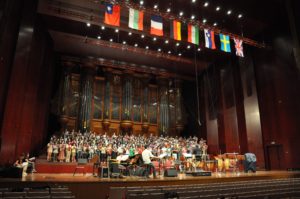
It has now been a little over a century since choral music began in Taiwan. We can safely say that choral music in Taiwan has flourished tremendously, and with the joint efforts of conductors, composers, singers, choral organizations, and even audiences, the choral scene in Taiwan is still growing continuously. We can definitely look forward to seeing more and more great choral music and musicians from Taiwan throughout the next century. There is indeed a bright future ahead of us.
Edited by Gillian Forlivesi Heywood, Italy
Taiwanese Choral Music Publishers
China Music Book Store (www.musicbooks.com.tw)
Formosa Singers (www.formosasingers.com.tw)
Taipei Chamber Singers (www.tcschoir.org.tw)
Taipei Philharmonic Foundation (www.tpf.org.tw)
Yue-Yun Music Publisher (www.musiker.com.tw)
In addition to these Taiwanese publishers, Earthsongs Music and Carus-Verlag Publishing have also published some Taiwanese choral compositions.
References
- Chen, Yu-Hsiu. One Hundred Years Music in Taiwan, Taipei: China Times Publishing Company, 1996.
- Hsu, Tsang-Houei, The Art of Choral Music, Taipei: The Council for Cultural Affairs, 1991.
- Hsu, Tsang-Houei, Yu-Hsiu Lu, Chuikuan Lü, Kuo-Huang Han, and Joanna C. Lee. Taiwan. Grove Music Online, ed. L. Macy (Accessed 11 October 2011), http://www.grovemusic.com
- Strimple, Nick. Choral Music in the 20th Century, Los Angeles: Amadeus, 2002.
- Su, Ching-Chun. The Development of Taiwanese Choral Music. Encyclopedia of Taiwan, ed. Council for Cultural Affairs, Taiwan (Accessed 11 October, 2011), http://taiwanpedia.culture.tw/web/content?ID=20963
- Weng, Chia-fen. The development and growth of choral music in Taiwan (1624- 1994). DMA dissertation, University of Texas, Austin. 1995.
- Yen, Lu-Fen, ed. Contemporary Composers in Taiwan. Taipei: TIPI, 2006.
- Hsu Mei-Ling. Music of Taiwan. Taipei: Taiwan Advocates, 2006.
- Yu, Yi-Jing. Du-Hei, The Black-faced General of Music. Taipei: China Times Publishing Company, 1998.

